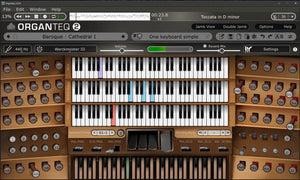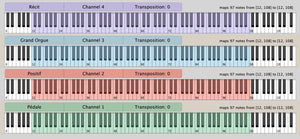Your Cart is Empty


Modartt Organteq 2
Physically modelled pipe organ
$269.00
Rated 5.0 out of 5 stars
1 Review
Description
Organteq is a physically modelled pipe organ which you can install on your computer (PC/Mac).
You can use any MIDI compatible keyboard, e.g. digital piano, to play it although a MIDI organ console and pedal board would make the experience more authentic.
Being physically modelled, the sound is computed in real-time and is adapted according to how you play. That way, it responds like a real organ. Moreover, the installation file size is just 30 MB (Megabytes). You can compare this with regular sampled virtual organs which may require up to 64 GB (Gigabytes). This makes Organteq much faster to load and does not require any specific hard drive for the installation.
On top of this, you have access to physical parameters which make it possible to tweak the sound of the pipes in unique ways, including reverb effects.
To give another example of why a physically modelled organ is to be preferred, is when playing note repetitions. On a real organ, you can hear subtle variations in the attack, even with sustain. The physical model reproduces these variations.
Organteq offers over 4,000 pipes, inspired from many great organ builders of the French Romantic and German Baroque periods: A. Cavaillé-Coll, G. Silbermann, T. Tröst, and others. The 68 organ stops, ranging from 32' to 1', can be assigned to 3 manual keyboards with a five-octave range, and a pedal keyboard with 32 notes.
What’s new:
Organteq 2 adds a new collection of German Baroque stops, an enhanced sound engine, new voicing parameters and improved sound design capabilities.
A set of 34 German Baroque aesthetics stops inspired by the works of organ builders such as Tröst, Schnitger and Silbermann have been added, along with an extended collection of French Romantic flue and reed pipes. Additional 32-foot reed and flue bass pipe models have also been implemented, bolstering the instruments low-end response.
Vast improvements have been made to the physical modelling of attack transients, rattling sound of loud reed pipes, room acoustics and more, with the results promising to deliver stunning playability and breathtaking realism. Every pipe of every stop can now be individually voice, with control over parameters such as chiff amount, air noise, wind jitter, brightness and more offering a huge range of tonal options.
The instrument’s console has been treated to an upgrade, too, and can now hold up to 50 stops and offers four monophonic couplers for bass and melody. There is now support for three assignable expression pedals, whilst the crescendo pedal has been expanded to 24 steps and can now be used to control couplers and tremulants. A new eight-channel audio routing matrix has also been added.
The GUI has been overhauled and now offers improved touchscreen compatibility, whilst VoiceOver (macOS) and Narrator (Windows) tools have been added for visually impaired users.
Tech Specs
ORGANTEQ 2 is available for macOS (10.7 or later), Windows (7 or later) and Linux (x86),both as a standalone instrument and as a 64-bit plug-in for VST, AAX and AudioUnits hosts.





